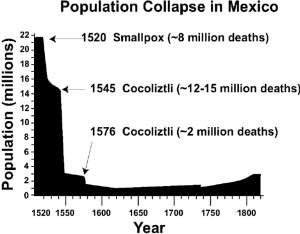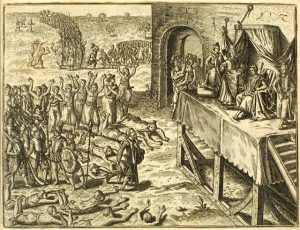In 1545 CE, we’ll look quickly at some of the usual story-lines but then take a deeper dive into a Portuguese-controlled zone in West Africa. The usual story-lines:
- King Henry VIII of England was fighting both the Scots (who won a battle) and the French (whose short-lived capture of the Isle of Wight the English reversed.)
- The Spanish conquistadores continued conquistadoring. In April, they founded the town of Potosí in modern-day Bolivia to act as a hub for the large-scale mining of silver deposits found in a nearby mountain. That silver funded most of the Spanish Empire until the empire’s demise in the early 19th century.
- In 1545, the indigenous people of present-day Mexico entered the terrible

CDC graph (2002) on the effects of epidemics on population of present-day Mexico Cocoliztli epidemic, which in three years killed an estimated 12-15 million of the 21 million who had lived in that area in 1520. Click here or on the graph for more details (or check out WP.)
- In 1545 CE, the Spanish Franciscan friar Bernadino de Sahagún embarked upon a 45-year ethnographic project to record the folkways (including the languages) of the peoples of Mesoamerica. Working with Nahua men who had been his students at the Colegio de Santa Cruz de Tlatelolco, per English-WP he, “conducted research, organized evidence, wrote and edited his findings… from 1545 up until his death in 1590. The work consists of 2,400 pages organized into twelve books; more than 2,000 illustrations drawn by native artists provide vivid images of this era.” It is now known as the Florentine Codex and in 2015 was designated by UNESCO as a work of World Heritage. (The image above is a drawing of indigenous smallpox victims from the Codex.)
- Over the other side of the Pacific, conquistador/mariner Yñigo Ortiz de Retez “discovered” and claimed for the Spanish crown a group of islands whose native inhabitants he thought resembled those of the West African area of Guinea; hence, he named it New Guinea. The Portuguese were not amused at this encroachment on their imperial turf and later imprisoned him.
- Protestant-Catholic things continued happening in Europe. In March, the Pope convened another “Diet” in the German city of Worms at which Protestant German princes demanded some rights. Spain’s Catholic monarch, Charles V, refused to allow this. This, though the previous year he had enrolled some German Protestant princes in his alliance against the (also Catholic) King of France. Go figure… Anyway, he was good at throwing his weight around and over-ruling the Pope.
- The Ottomans dethroned the Prince of Wallachia and defeated an alliance of Georgian dynasties.
So now, the Portuguese in West Africa:
In 1545 CE, English-WP tells us, Diogo I Nkumbi a Mpudi overthrew his uncle Pedro I to become manikongo of Kongo. Whoa! Those indigenous West African leaders with Portuguese names– definitely worth my while to “explore” some.
So the Kingdom of Kongo had been formed in around 1400 CE. It was located in an area that straddles present-day Democratic Republic of Congo, Republic of Congo, Gabon, and norther Angola and is spelled “Kongo” to differentiate it from the two present-day “Congos”. It seemed to have become established as a “Kingdom” under the influence of the Portuguese, whose explorer Diogo Cão made contact with the area’s people after sailing up the previously uncharted Congo River,
finding Kongo villages and becoming the first European to encounter the Kongo kingdom.[20] Cão left men in Kongo and took Kongo nobles to Portugal. He returned with the Kongo nobles in 1485. At that point the ruling king, Nzinga a Nkuwu, converted to Christianity.[21] Cão returned to the kingdom with Roman Catholic priests and soldiers in 1491, baptizing Nzinga a Nkuwu as well as his principal nobles, starting with the ruler of Soyo, the coastal province. At the same time a literate Kongo citizen returning from Portugal opened the first school. Nzinga a Nkuwu took the Christian name of João I in honor of Portugal’s king at the time, João II.[22]
João I ruled until his death around 1506 and was succeeded by his son Afonso Mvemba a Nzinga.
King Afonso I, we are told,
worked to create a viable version of the Roman Catholic Church in Kongo, providing for its income from royal assets and taxation that provided salaries for its workers. With advisers from Portugal such as Rui d’Aguiar, the Portuguese royal chaplain sent to assist Kongo’s religious development, Afonso created a syncretic version of Christianity that would remain a part of its culture for the rest of the kingdom’s independent existence. King Afonso himself studied hard at this task. Rui d’Aguir once said Afonso I knew more of the church’s tenets than he did.
In 1509, instead of the usual election among the nobles, a hereditary European-style succession led to the African king Afonso I succeeding his father, now named João I.
Later, this:
In the following decades, the Kingdom of Kongo became a major source of slaves for Portuguese traders and other European powers. The Cantino Atlas of 1502 mentions Kongo as a source of slaves for the island of São Tomé. Slavery had existed in Kongo long before the arrival of the Portuguese, and Afonso’s early letters show the evidence of slave markets. They also show the purchase and sale of slaves within the country and his accounts on capturing slaves in war which were given and sold to Portuguese merchants. It is likely that most of the slaves exported to the Portuguese were war captives from Kongo’s campaigns of expansion. In addition, the slaving wars helped Afonso consolidate his power in southern and eastern border regions.[24]
Despite its long establishment within his kingdom, Afonso believed that the slave trade should be subject to Kongo law. When he suspected the Portuguese of receiving illegally enslaved persons to sell, he wrote to King João III of Portugal in 1526 imploring him to put a stop to the practice. Ultimately, Afonso decided to establish a special committee to determine the legality of the enslavement of those who were being sold.
These details about how Diogo I came to power in 1545 are interesting:
A common characteristic of political life in the kingdom of Kongo was a fierce competition over succession to the throne. Afonso’s own contest for the throne was intense, though little is known about it. However, a great deal is known about how such struggles took place from the contest that followed Afonso’s death in late 1542 or early 1543. This is in large part due to detailed inquest conducted by royal officials in 1550, which survives in the Portuguese archives. In this inquest one can see that factions formed behind prominent men, such as Afonso I’s son, Pedro Nkanga a Mvemba and Diogo Nkumbi a Mpudi, his grandson who ultimately overthrew Pedro in 1545. Although the factions placed themselves in the idiom of kinship (using the Portuguese term geração or lineage, probably kanda in Kikongo) they were not formed strictly along heredity lines since close kin were often in separate factions. The players included nobles holding appointive titles to provincial governorships, members of the royal council and also officials in the now well developed Church hierarchy.
Then, more about the Kongolese king, the Portuguese, and contestation over the slave trade:
Problems also arose between Diogo and the Portuguese settlers at Sao Tome known as Tomistas. According to a treaty between Kongo and Portugal, the latter were only to trade within the former’s realm for slaves. That meant the Portuguese were restricted to the slaves offered by King Diogo or those he authorized to sell slaves. Every year the Tomistas would come with 12 to 15 ships to carry back between 400 and 700 slaves (5,000–10,000 slaves a year). This was not enough to take advantage of Kongo’s ever-growing supply of slaves thanks to wars on its eastern frontier. The captains would try to overload their cargos, resulting in revolts. However, the factor that actually broke the deal was the Tomista habit of sailing upriver to the Malebo Pool to purchase slaves from BaTeke traders who were increasingly taken with European goods over the nzimbu shells the manikongo offered them. Enraged by this breach of contract, King Diogo broke off relations in 1555 and expelled 70 or so Portuguese living in his realm (many of whom had lived there for a long time and had African wives and mixed-race children).
Of course, I was tempted to head over to English-WP’s page on the history of São Tomé…
I will certainly need to do that some time, since São Tomé was literally the cradle of the whole European-colonial practice of establishing sugar plantations on islands (and some coastal mainland areas) that were far south enough to support sugar-cane cultivation and that all required the massive use of enslaved labor to be profitable… And thus, of the whole, large-scale trans-Atlantic trade in enslaved persons that would soon be coming, and in which the Portuguese played such a large continuing role.

But for now, understanding a little more about Portugal’s imperial practices with regard to Kongo is also informative. One crucial difference between what the Portuguese had done there and what the Spanish later did after they “discovered” the Americas was that the Portuguese seemed much more inclined to insinuate themselves into positions of power with Kongolese rulers and society, rather than just impose themselves wholesale and through massive violence on the entire territory. The print shown here has no provenance followable beyond the WP page on which I found it. But presumably it was published in Portugal or elsewhere in Europe… That encounter was very different from the way in which the Spanish treated local rulers in the Americas! Plus, there was that whole record of the Portuguese introducing Catholic Christianity in a very “gentle” way that allowed for syncretism with existing local belief-systems…
Plus, of course, there was the continued policy of working with the local ruler on continuing commercial deals– of which, in this case, the trade in enslaved persons was a very significant part.
Go, Christianity, huh! (This comment was ironic.)
